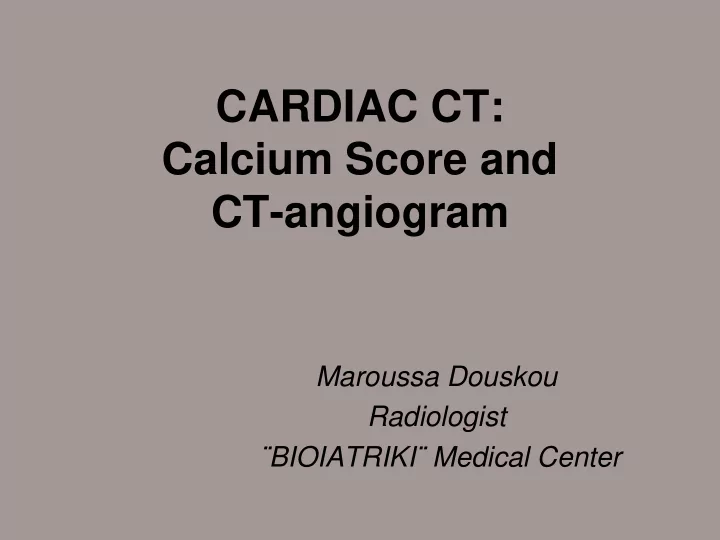

CARDIAC CT: Calcium Score and CT-angiogram Maroussa Douskou Radiologist ¨BIOIATRIKI¨ Medical Center
• Cardiovascular diseases remain the leading cause of morbidity and mortality in industrialized nations. • Invasive coronary angiography (ICA) has been the standard of reference for diagnosis of CAD. • Non invasive techniques (EBCT,MSCT,MRI) and their role are still being debated .
Types of Coronary CT imaging • Coronary Calcium Scoring • MSCT (multislice CT) : A new form of cardiac imaging. This is a way to measure obstruction similar to a cardiac catheterization. It is NOT a functional test.
Coronary Calcium Scoring • Calcium scoring for risk assessment. • This is for asymptomatic patients and is not yet recommended as a routine screen. • CCS can be normal in 5% of patients who have myocardial infarcts
Coronary Calcium Scoring • Agatston Score : based on maximum CT numbers • Calcium Mass Score : amount of calcium • Volume Score : volume of a plaque
Calcium Volume Scoring Area = 8 mm 2 Area = 15 mm 2 Peak CT = 290 Peak CT = 450 Score = 8 x 2 = 16 Score = 15 x 4 = 60 Coronary Calcium Scoring Hn x-factor 130-199 1 200-299 2 300-399 3 >400 4
The Calcium Scale The calcium scale is a linear scale with 4 calcium score categories: 0 none 1–99 mild 100–400 moderate >400 severe *Calcium score correlates with risk of events and likelihood of obstructive CAD*
Coronary Calcium Scoring • Initial ACC/AHA guidelines “may be useful in selected patients”… • Added prognostic power to conventional risk stratification tools (Framingham) • Revised guidelines (and reimbursement for service) likely forthcoming
MSCT Coronary Angiography First whole-body CT cross-section through a human thorax, generated by Ledley et al in 1974 ( Science 1974;186:207)
MSCT Coronary Angiography • Initial studies 5-10 years ago used 4-slice MSCT. Then came 16-slice (we still use these in some centers) and now 64-slice MSCT is arriving in just the last few years. • The 64-slice CT is the current standard (approved in 2004). • Dual head 64-Slice CT. (can handle faster heart rates) • 256-slice CT angiograms are just starting to be evaluated.
MSCT Coronary Angiography • Patient preparation • Data acquisition • Image reconstruction
Clinical Indications for MSCT • Non-invasive coronary angiography (CTA) in the symptomatic low-risk patient or asymptomatic intermediate- risk patient * A negative test (normal CTA) has a 98% chance of revealing normal coronary arteries on invasive angiography *
When to Consider MSCT • Equivocal stress test or persistent symptoms despite negative stress test • Prior to non-coronary cardiac surgery (valve or congenital repair) • Patients with difficult access or on therapeutic warfarin • Suspected coronary anomalies
When to Consider MSCT • Idiopathic dilated cardiomyopathy • Cardiac transplant evaluation • Patients to undergo electrophysiologic intervention (AF ablation, BiV pacing) • Selected patients pre- and post-bypass surgery (aortic pathology, graft patency)
Soft Plaque Visualization
Pulmonary Vein Stenosis Vasamreddy et al. Heart Rhythm (2004) 1, 78-81.
The Great Promise of MSCT The “Triple Rule-Out”
CTA Limitations • Rapid (>80 bpm) and irregular HR • High calcium scores (>800-1000) • Stents • Contrast requirements (Cr > 2.0 mg/dl) • Small vessels (<1.5 mm) and collaterals • Obese and uncooperative patients • RADIATION EXPOSURE
Radiation Risks • Exact quantification of harmful effects of radiation difficult to ascertain • For a child under age 15, the risk of cancer death from a single CT scan is approximately 1 in 500 • For a 45 year old adult, the risk of death from cancer from a single CT exam is about 1 in 1,250 Brenner et al. Radiology, 231(2):440-445.
Effective Radiation Doses for Various Tests • Bone Density 0.01 mSv • CXR: 0.02 mSv • Mammogram: 0.7 mSv • CT of the head: 2 mSv • CT colonoscopy 5 mSv • CT of the abdomen: 10 mSv • Stress Gated Myocardial Perfusion Scan SPECT: 10-11 mSv • CT chest: 13 mSv • MSCT angiogram: 15 mSv ( MEN ) 21 mSv (w) – Can be reduced 40% if ECG controlled X-ray tube current modulation is used. • Coronary angiography: 6-30mSv • CT chest/abd/pelvis: 35 mSv • Dose allowed for radiological personnel: 20 mSv/year
Radiation Dose Reduction • STEP AND SHOOT MODE ( SAS ) acquisition of data only in predefined phases of the R-R interval • Heart rate <70 bpm • BMI<30 • Radiation dose <6mSv
MSCT Coronary Angiography Accuracy • Accuracy of testing: – For 64 slice CTA: (for clinically significant occlusions, >50%) • Sensitivity: 89 % – (If cardiac cath positive (gold standard), CTA will be positive 89% of the time) • Specificity: 96% – (if cath negative, the CTA will not find it 96% of the time.) • Negative Predictive Value: 99% – (if negative CTA, cath is negative 99% of time) • Positive Predictive Value: 78% – (if positive CTA patient has positive cath 78% of the time) » Clinical Cardiology vol. 30 , 9/07
Summary Cardiovascular Imaging • Multi-slice CT (MSCT) not likely to replace conventional angiography • Post-processing of images for MSCT angiography time & labor intensive • Major strength of CTA is its high negative predictive value • CMR to become the preferred cardiac imaging modality in the future
Which Test for Which Patient? • All modalities are improving • No single modality fits all applications and all patients • Choice of initial test depends on the specific clinical question in individual patient
Conclusions and future perspectives • Improved diagnostic accuracy • Combined evaluation of anatomy and cardiac function (MSCT-PET-SPECT) coronary tree-perfusion scan-cardiac metabolism and function • Coregistered MRI viability mapping and MSCT optimize surgical revascularization planning
Conclusions and future perspectives • Detection of pulmonary embolism • Aortic dissection • Wider use in emergency rooms ¨ Triple Rule Out ¨ in patients with chest pain
Thank you for your attention
Recommend
More recommend